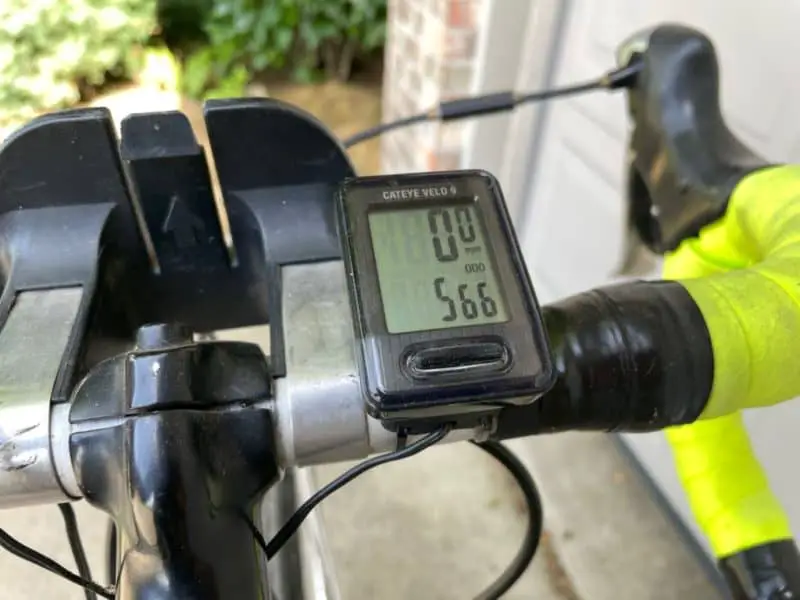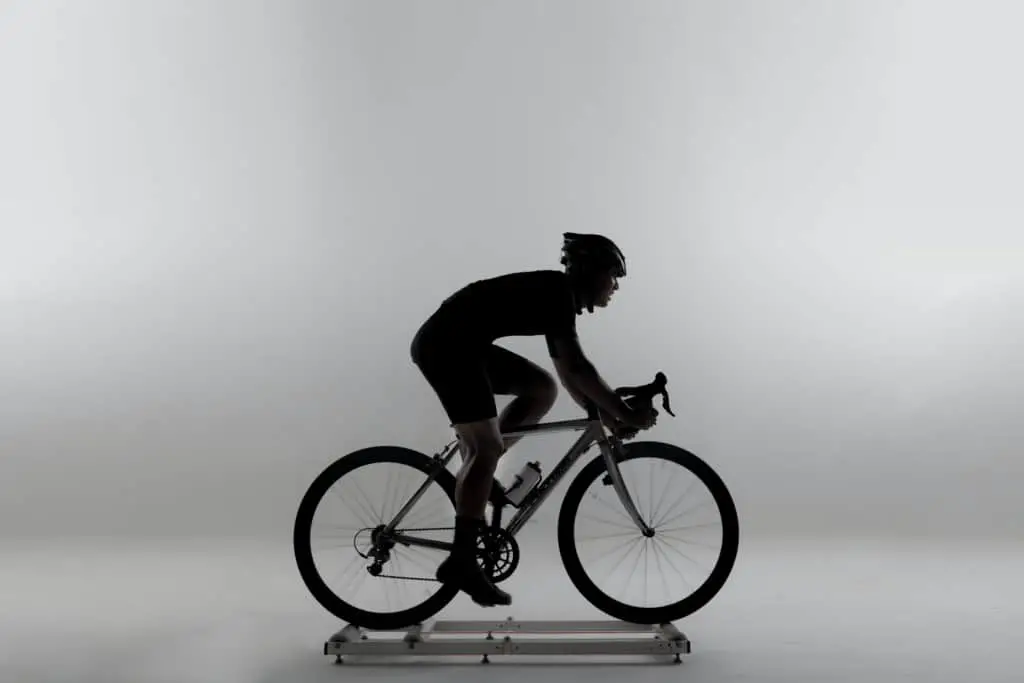If you are looking to get fitter and faster on your bike, you’ll need some kind of method to track just how well you are doing. A great way to do this is to measure your distance traveled. Even if you’re riding on an indoor bike trainer, you can still measure the distance you ride.
In this article, we’ll talk about four ways to measure distance on an indoor bike trainer. And although riding an indoor trainer isn’t the same as riding outside on the road, it can give you a pretty good experience and help you work out even when you can’t get out.
Let’s get started!
1. Use a Bike Computer
One way to measure distance on your indoor trainer is to use your bike computer just like you would use it outdoors. The only difference is, your bike won’t be going anywhere.
For example, when I ride on my rollers (i.e. my bike trainer), I can track all my data and distance with my Garmin just like I would if I were heading out the door and hitting the road. The bike computer will pick up all of the information from the sensors in the same way.

Is it Accurate?
The more sensors you use, the more accurate your distance data will be. Your bike computer can track distance, speed, cadence, heart rate, and power, just like when you’re riding outside. There is a slight difference, though.
Riding on a bike trainer isn’t the same as riding on the road. On a standard trainer, your elevation won’t change. And on some trainers, the resistance won’t change either. So this would affect things like your average speed. Since you won’t be going uphill or down, your average speed (and therefore your distance) will be more consistent.
To get a more realistic experience, try to keep your trainer’s resistance as close to the feeling of the road as possible. On an older trainer style, you might have to do this manually by clicking a few buttons. On newer trainers with newer technology, you can use an app or online program to do this.
Make Sure It Uses a Rear Wheel Sensor
What’s unique about riding a trainer is that your front wheel will probably be stationary. It does not need to spin. So if you are using a speed sensor, it will need to go on your rear wheel. When you’re riding outside, you’ll likely have the speed sensor on your front wheel, but since bike computers calculate speed (and therefore distance) based on the number of rotations your tire makes, the sensor has to go on the tire that is actually spinning.
And if you are using a full-on smart trainer (rather than just a bike computer), such as my Wahoo Kickr, it will provide you with all the data you need. For example, a direct-drive smart trainer will have built-in cadence, power, and speed sensors. You can connect them to your bike computer or an app on your smartphone. It will calculate the distance for you and give you resistance and even workouts options, depending on the type of bike computer you use.
If you don’t have a bike computer and a smart trainer, you can still figure out your average speed, but you may need to estimate it.
2. Estimate Using Your Average Speed
You can use your average speed to get an estimate of the distance you rode on your trainer. For example, if you know, you typically ride at 14mph on flat roads, and you put in a similar effort on your trainer, you can figure that in 30 minutes of riding on an indoor trainer, you probably rode approximately 7 miles.
The caveat here is that you still need to keep your trainer’s resistance as close to the feeling of the road as possible. Then try to keep your cadence and effort the same as you would typically ride. It won’t be as exact as if you measured with sensors, but it will still give you a pretty good idea of how far you went.

If you don’t want to estimate your average speed, you can always estimate based on your RPE.
3. Estimate Based on Effort
RPE, or rate of perceived exertion, will give you a good idea of how far you traveled when comparing it to your past rides.
RPE is basically a scale of how much effort you feel you are putting out. For example, if you feel like you are riding at an 8 out of 10, you’ll be putting out a pretty hard effort. Compare that to the last time you rode at 8 out of 10 on a flat road, and you’ll get a decent idea of how far you were able to go. From there, you can estimate your time and cadence and your distance, especially if you compare it to data you have from your previous rides.
However, there are a lot of variables when using RPE to estimate your distance, making this the least accurate method. For example, if you are tired because you stayed up too late the night before, your RPE will be higher than average. Or if you aren’t feeling well or did a tough effort or a lot of miles the day before, what feels really hard today might be pretty easy when you are more rested.
If improving your fitness is your goal, then listening to your body is a critical component of getting faster and covering further distance.
On a side note, read this guide if you think you are fit enough for the Navy PRT Bike assessment.
Using RPE to calculate distance isn’t foolproof, but it does give you a rough estimate of the distance you covered on your trainer. You might prefer to use another method, though.
Online cycling platforms is another option that will also give you a pretty accurate means of tracking your distance.
4. Online Cycling Platforms
If you’ve invested in a trainer, especially a smart trainer, you might want to consider using an online platform such as Zwift, Rouvy, RGT, TrainerRoad, or Sufferfest. Most of these platforms will take the data from your trainer or sensors and convert them into an online gaming experience.
For example, Zwift uses your data to calculate algorithms that will move an avatar of you on a bicycle through roads, cities, courses, over flat roads, hills, and descents. You can also ride with and interact with riders all over the world.
From there, Zwift will take whatever sensor you have to calculate your distance and speed. For example, if you have a power meter, that will give you a more accurate reflection of the distance you have traveled. Still, if not, Zwift can take your speed and cadence data and transform it into estimated power and, therefore, distance.
While online platforms can’t mimic road conditions, speed, and distance perfectly, they do give you a pretty accurate way to measure how much you’ve covered in a session. And since their metrics are consistent within their platform, you can see how little or much you are improving over time.
Should You Measure Distance on a Bike Trainer?
It is definitely worthwhile to measure your distance on a bike trainer. This can help you ensure you are getting in enough high-quality miles to improve your fitness without overtraining. It can also help you prepare for short, strenuous efforts, like a crit, or more extended slower efforts, like a century ride.
That being said, if you are genuinely working on improving your fitness, it is also worthwhile to measure your time, your cadence, your heart rate, and your power.
Measuring your power data will help you see if you are getting stronger over time, while tracking your heart rate can help you make sure you are putting out the right amount of effort without overdoing it. Measuring your cadence will help you find the balance between muscle and cardio efforts to reduce fatigue while you ride.
Combined with measuring the distance you travel, all of these metrics work together to help you get a clearer picture of your fitness level and the areas you can work on to improve your fitness level and ride your bike faster, further, and stronger.
If you want to learn more about bike trainers, read our article about bike trainer essentials.
